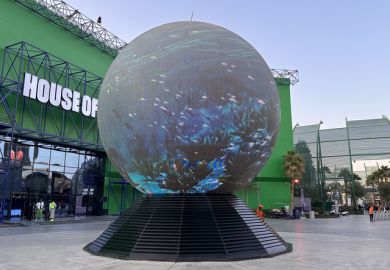The cyanotype is a wonderfully simple work of art – a primitive photograph. It is a photosensitive sheet of paper over which one may lay an object, out in the sun, and allow the light to do its work. Washed clean in a sink or bath, a magical, ghostly image appears, literally out of the blue. It is the same process by which early blueprints were made, and in the 1840s, the botanist Anna Atkins created wonderful images of sea algae using the method, as Carol Mavor, professor of art history and visual studies at the University of Manchester, notes in her evocative new book – a work which wanders at will over a world of blue. Indeed, it is easier to read Blue Mythologies as enhanced poetry, rather than prose.
Thus, in a typically allusive passage, Mavor discusses a contemporary cyanotype made by artist Annabel Dover of her grandmother’s silk stocking from the Second World War, a memento of her grandfather’s absence as a soldier lost in action. This fragile image – the delicate silk weave imprinted in blue – segues to John Everett Millais’ Ophelia, and the image of model Lizzie Siddal lying in the cooling waters of a tin bath. “The stocking is Ophelia (metaphor). The stocking is missing (metonymy). It is the missing husband. It is a divided subject. Like this book. Like blue.”
Mavor’s book could hardly be less constrained by its divided subject. Hers is a stream of consciousness, illustrated by a lavish wash of colour reproductions, meandering from the blue and white china bowl in which Horace Walpole kept his goldfish (and in which his favourite cat drowned), to Paul Gauguin’s Young Girl Dreaming, the result of the artist’s blue dreaming which would end up in the Polynesian blue sea: “Yet, the more I dream of Gauguin, the closer he gets.”
Along the way, Mavor’s aesthetic eye takes in the Blessed Virgin Mary, whose blue gown stood for overarching heaven, and which was represented in Renaissance art by the most expensive artist’s pigment – genuine ultramarine. Extracted from lapis lazuli, and almost a precious stone in paint form, this profound shade is gorgeously unravelled in Giotto’s Last Judgement, in which an angel is seen tearing away a section of the blue sky to reveal a jewelled chamber behind it. And from Giotto it seems but a minor leap, albeit one of centuries, to Derek Jarman’s last film, Blue (1993), made as he was sent blind by Aids, projecting only a screen flooded with azure (“directly into the realm of colour – as Yves Klein had wished”) while the film-maker/artist intoned a stream of consciousness, “Blue of my heart/Blue of my dreams/Slow blue love/Of delphinium days.”
Mavor’s entire book is one long reverie, and for her, “dreams are a form of pilgrimage”. Sometimes its connections become a little too attenuated, and there are some minor infelicities. The blue, or fairy, penguin of Australia doesn’t have blue skin but blue feathers, for instance (although they are a remarkable cobalt blue when glimpsed paddling out at sea, under the intense Antipodean light). And for her sake, I wish Mavor had been able to see a blue whale, the largest, bluest animate object on earth, and witness its strange, eerie petrol-blue skin that seems to change like liquid crystal.
But one must forgive such lapses and lacunae as Mavor dares to set herself adrift. Venice is a powerful locale for her, as she riffs, in a poignant section, from the lagoon’s waters to Thomas Mann’s Death in Venice and the beautiful boy Tadzio, dressed in his blue sailor suit, to the faintly camp photographs of early 20th- century American photographer Fred Holland Day, who, around the same time, was posing his own beautiful boys in the rocky bays of Maine where the Atlantic’s reflection runs clear and deep.
Ultimately, overwhelmingly, abidingly, blue is the sea and sky. An unrepeatable colour, utterly evanescent and extraordinarily eternal, as Mavor writes: “The blue of the sky is preferentially scattered towards our eyes from rays of light passing over our heads and interacting with molecules of atmospheric air; these atoms have not changed since the time Giotto was painting in Padua, when the blue of the sky was exactly as it is now.” It is in such airy insights that Blue Mythologies succeeds in directing our eyes anew.
Blue Mythologies: Reflections on a Colour
By Carol Mavor
Reaktion, 208pp, £22.00
ISBN 9781780230832
Published 26 September 2013
Register to continue
Why register?
- Registration is free and only takes a moment
- Once registered, you can read 3 articles a month
- Sign up for our newsletter
Subscribe
Or subscribe for unlimited access to:
- Unlimited access to news, views, insights & reviews
- Digital editions
- Digital access to THE’s university and college rankings analysis
Already registered or a current subscriber?




